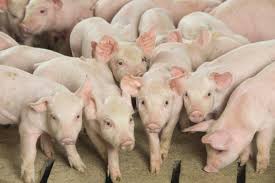

Sanitation
Freshly weaned pigs have just experienced an incredibly stressful change, and that stress can be highly detrimental for their already immature immune systems. On top of this, any maternal antibodies that were conveyed to the pig from the sow will be waning within the first two weeks of placement, thereby elevating their risk from any exposure to environmental pathogens. Effective power-washing must be completed between every group entering the facility – especially if previous groups have faced a challenge. De-greasers and/or hot water will be a great help at eliminating any biofilm on floor and feeder surfaces, which cold water alone may not be able to remove. A post-washing inspection is also helpful, as spaces in the floor, under the lip of the feeder or underneath water bowls are commonly missed – and these areas can all harbor enough pathogens to make a weaned pig sick.
Pathogen control
Of course, other equipment in the facility could also be responsible for the presence of pathogens. To avoid tracking in pathogens from the outside world, boots should be thoroughly cleaned and disinfected before workers enter the rooms of newly weaned pigs. Gruel feeders and bowls should also be thoroughly cleaned and disinfected between groups. Mats are a great way to start pigs on solid feed, but if the mats are aging and fraying significantly, they can be difficult to disinfect effectively, making them a haven for disease. Feed carts, scoops, coveralls, hoses and even hats are examples of other items that could potentially harbor disease. Wooden surfaces are almost impossible to disinfect sufficiently and should be painted with latex paint to seal off any potential hiding spots for bacteria and coccidia.
Once the pens have been sufficiently cleaned, it is important to also select a disinfectant that will effectively eliminate the pathogens present in the facility. There are several product options on the market, all of which have their pros and cons. Select one based on its coverage, the time needed to take effect and its ease of application.
Proper nutrition
A young pig has very specific nutritional needs, and if we expect too much of them, they will often fail. A big challenge with starting pigs is making sure that they all have access to the proper diet stage. In large facilities that can take weeks to fill, the amount of starter ration that the first pigs get is often much different than the amount allowed for the last pigs. Of course, bins and feed lines should be emptied between groups, as a pig’s last diet is not fit to be the first feed a recently weaned pig will eat. Finally, animals that are not eating in the pen – either because they are sick or just slow learners – will have looser stools because of their decreased solid feed intake. These animals should be placed in a separate hospital or special-needs pen so they can receive more intensive care to get back to a full feed intake.
There are many factors to consider when evaluating the cause and treatment of diarrhea in a group of recently weaned pigs. Be careful not to fall into the trap of missing all of the influencing factors; otherwise, a small challenge could quickly become a crisis. Ask questions, make sure the environment is correct for the pigs’ group size and weight, get your veterinarian and nutritionist involved, and make sure to record your successes and failures as you go. With patience and understanding, even the biggest challenges can be overcome!
For more information, check our Mobile App #Jaguza Livestock App
 Contact Jaguza Support
Contact Jaguza Support